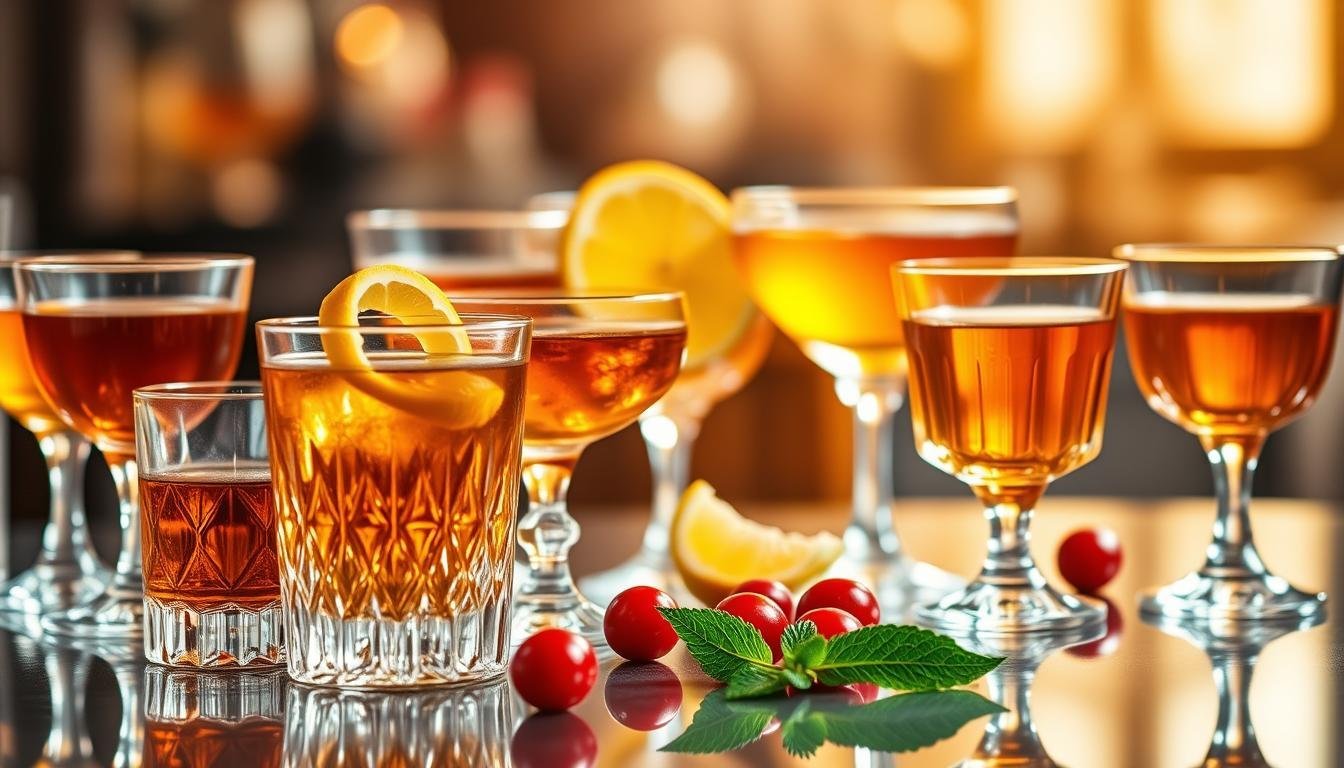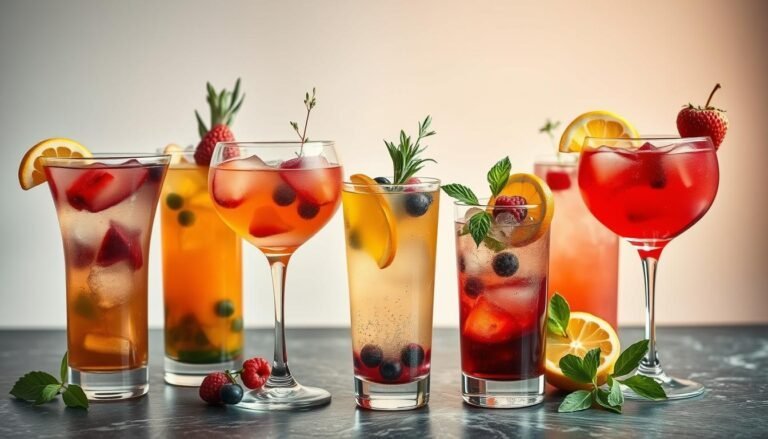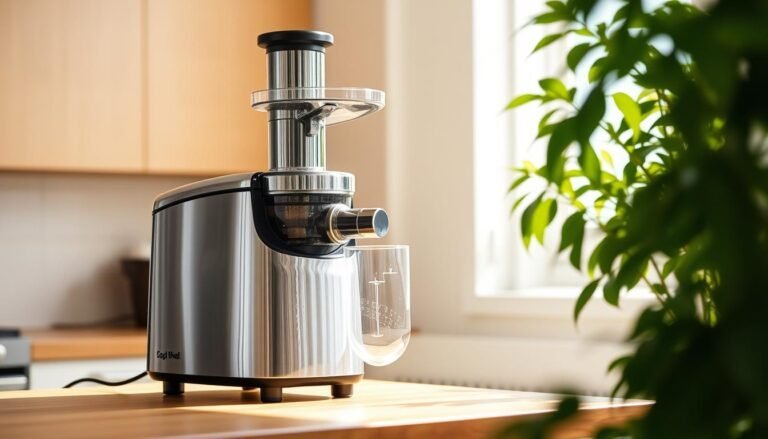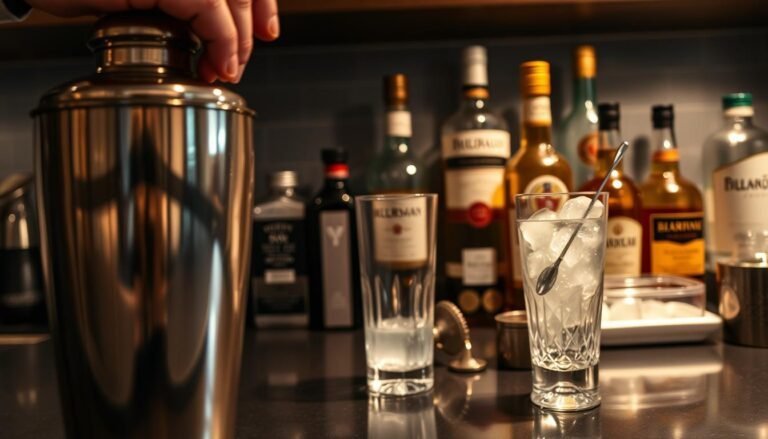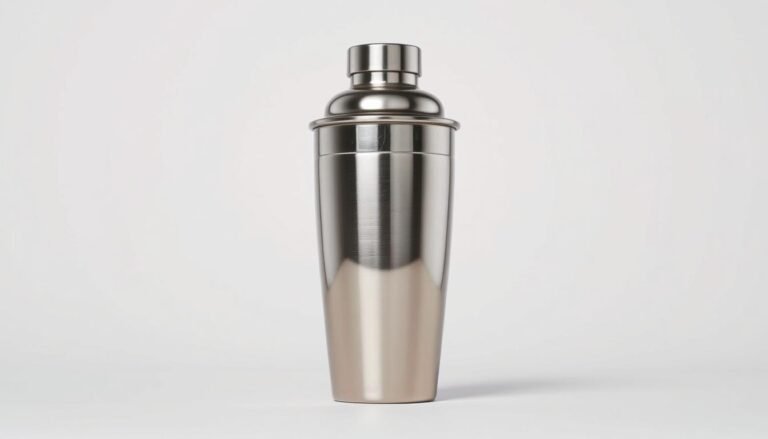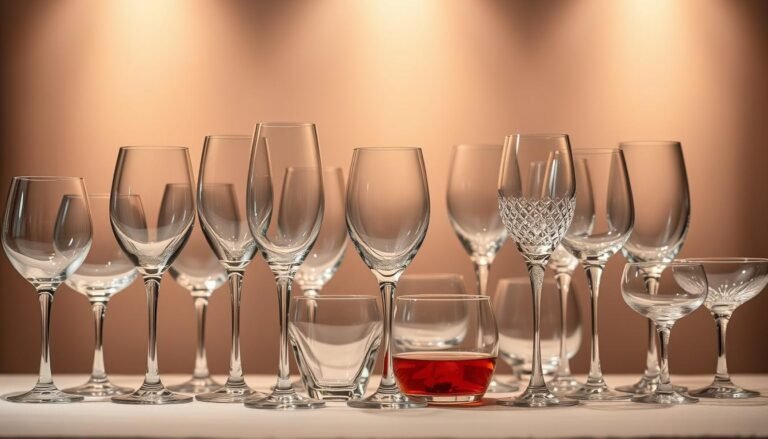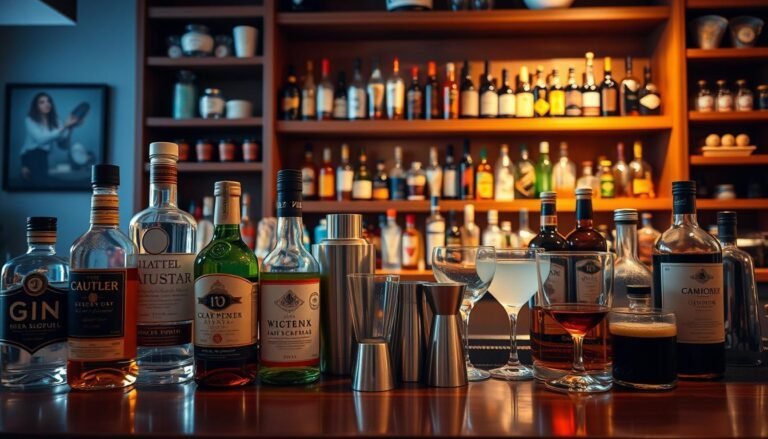Disclosure: This Post Contains Affiliate Links; We earn a commission on purchases.
The world of classic cocktails is vast and diverse. It offers a wide range of flavors and experiences. This is true for both enthusiasts and professionals.
Exploring the different classic drink categories can deepen your appreciation for mixology. It also helps you develop your skills in making unique and delicious cocktails. This guide will give you an overview of the main categories and what they offer.
Key Takeaways
- Understanding the basics of mixology is key to making great cocktails.
- Classic drink categories provide a wide range of flavors and experiences.
- Exploring different categories can help you improve your mixology skills.
- Classic cocktails are a fundamental part of the mixology world.
- Knowing the main categories can make you appreciate mixology more.
The Evolution and Significance of Drink Categories
The story of drink categories is really interesting. It shows how culture and history have changed over time. Different drinks have come to be because of many cultural and historical reasons.
How Drink Classifications Developed Through History
Drink categories have changed a lot over centuries. The classic cocktails of the 19th and early 20th centuries were shaped by many things. These include the types of spirits available, social trends, and cultural exchange.
Why Understanding Drink Categories Enhances Appreciation
Knowing about these categories makes us appreciate mixology basics more. When we understand the history and culture behind drinks, we see the skill in making classic cocktails.
Major Spirit Categories and Their Distinctive Qualities
Exploring the major spirit categories shows a wide range of production methods and flavors. These categories help define popular spirits. They also guide fans in making craft cocktails and enjoying different drink recipes.
Whiskey Family: Bourbon, Scotch, Rye, and Irish
The whiskey family is known for its complex flavors. These flavors come from how it’s made and where it’s from.
Production Methods and Flavor Profiles
Different whiskeys are made in unique ways. For example, bourbon gets its rich taste from being aged in new charred oak barrels. Scotch, on the other hand, gets its smoky taste from the malting process.
Regional Variations and Traditions
Where whiskey is made affects its taste. For instance, the climate and water in different places can change the whiskey’s flavor. Irish whiskey is smooth because it’s triple-distilled. Rye whiskey is spicy.
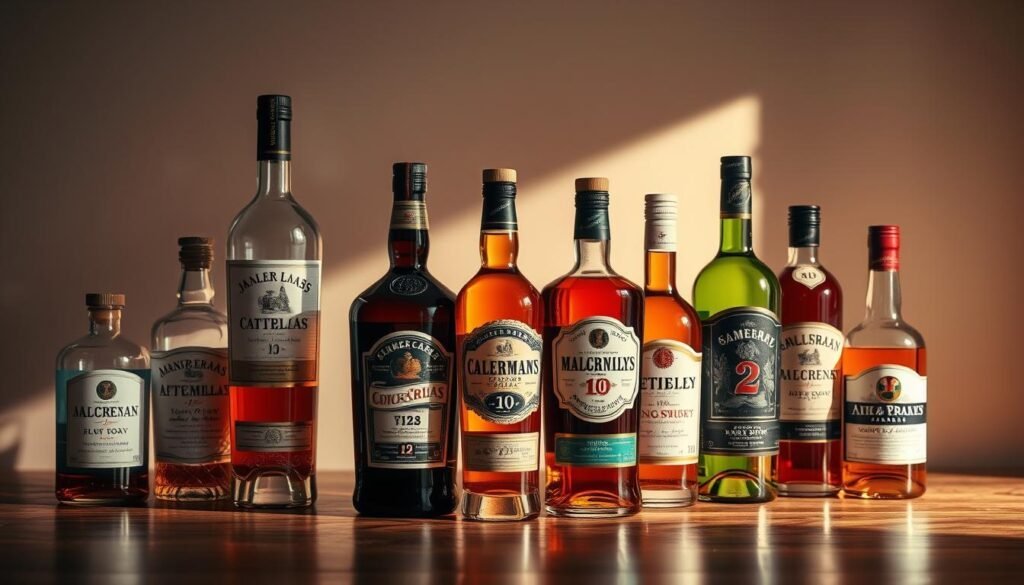
Clear Spirits: Vodka, Gin, and White Rum
Clear spirits are great for craft cocktails. Their tastes come from how they’re made and what they’re based on.
Distillation Techniques and Base Ingredients
Vodka is made to be neutral-tasting. Gin gets its flavor from botanicals during distillation. White Rum is made from sugarcane juice or molasses and is less strong.
Versatility in Cocktail Applications
Clear spirits are key in many drink recipes. Vodka is good for many cocktails because it tastes neutral. Gin adds complexity to drinks like the Negroni. White rum is great in Daiquiris.
Aged Spirits: Dark Rum, Brandy, and Aged Tequila
Aged spirits get complex flavors from aging. They’re good for sipping or mixing.
Maturation Processes and Flavor Development
Aging in oak barrels adds rich flavors to spirits. Dark Rum gets a deep flavor. Brandy becomes fruity. Aged Tequila gets a smooth, oak taste.
Sipping Versus Mixing Considerations
Aged spirits can be enjoyed neat or in craft cocktails. Whether to sip or mix depends on the spirit’s taste and the cocktail you want.
Classic Cocktail Families and Their Foundations
Knowing about classic cocktail families is key for bartenders and fans. These groups share common ingredients, ways to make them, and where they came from.
Spirit-Forward Cocktails: Old Fashioneds, Manhattans, and Martinis
Spirit-forward cocktails focus on the main spirit. They have few extra ingredients. The Old Fashioned, Manhattan, and Martini are great examples. They let a good spirit stand out.
An Old Fashioned has bourbon or rye, sugar, bitters, and citrus peel.
Citrus-Based Drinks: Sours, Daisies, and Collins
Citrus-based cocktails use citrus juice, spirit, and sweetness. The Whiskey Sour is a good example. It mixes whiskey, lemon juice, and simple syrup.
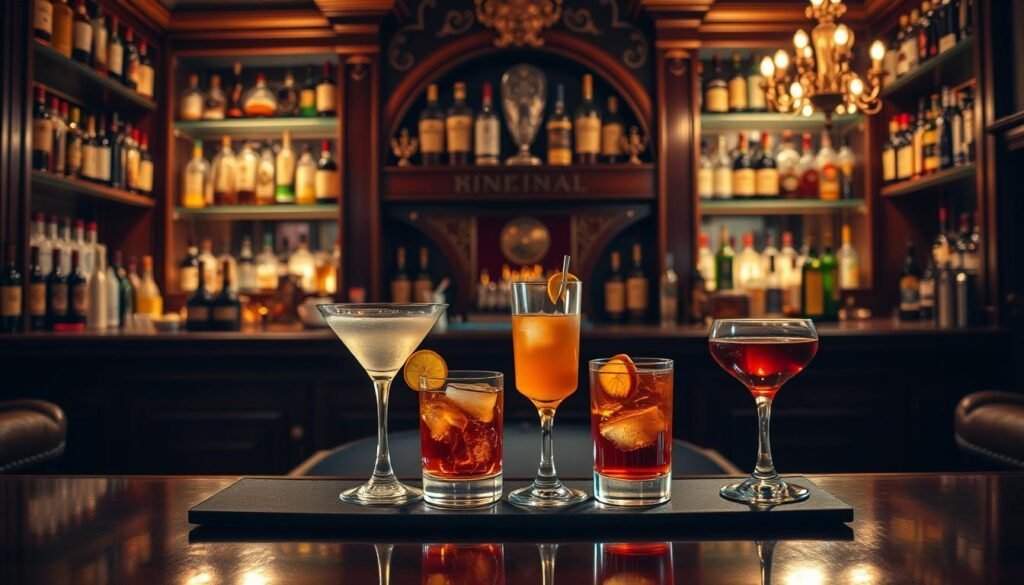
Refreshing Highballs and Spritzers
Highballs and spritzers are light and refreshing. They mix a spirit with more mixer, like soda water or prosecco. They’re great for hot days or laid-back events.
Complex Tropical and Tiki Cocktails
Tropical and Tiki cocktails are complex and full of exotic flavors. They mix different spirits, juices, and syrups. This creates deep flavors that feel like a trip to a tropical place.
Wine and Beer Categories for the Discerning Drinker
For those who love drinks, knowing about wine and beer can make drinking better. The world of drinks is full of choices for fans.
Wine Classifications Beyond Red and White
Wine isn’t just red or white. Learning about different wines can make you appreciate them more.
Understanding Varietals and Regions
Wines like Chardonnay, Merlot, and Pinot Noir taste different. Where the wine comes from also matters. For example, Bordeaux and Burgundy wines are famous for their unique tastes.
Sparkling, Fortified, and Dessert Wines
There’s more than just regular wine. You have sparkling wines like Champagne, fortified wines like Port and Sherry, and sweet dessert wines. These offer a wide range of tastes for wine lovers to try.
The Spectrum of Beer Styles
Beer comes in many styles, from light lagers to rich ales. Knowing about these can help beer fans explore more.
Ales Versus Lagers: Fundamental Differences
Ales and lagers are different because of how they’re made. Ales are made at the top, giving them fruitier tastes. Lagers are made at the bottom, making them cleaner and crisper.
Craft Beer Categories and Flavor Profiles
Craft beer has become very popular. Breweries make many styles, from IPAs to stouts. Each style has its own taste, shaped by hops, malts, and how it’s brewed.
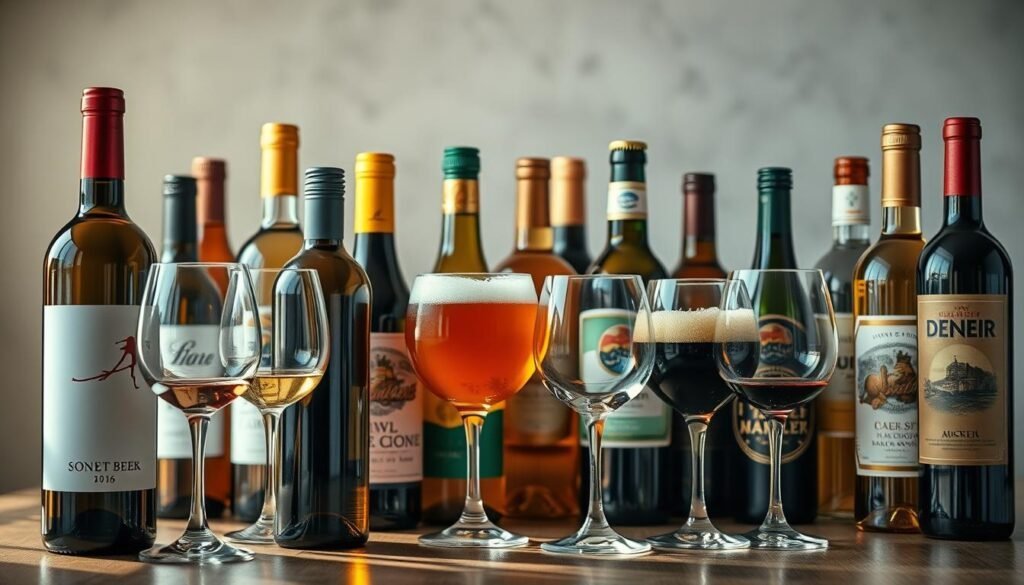
The Growing World of Non-Alcoholic Drink Categories
More people want healthier drinks, leading to a boom in non-alcoholic options. This boom is seen in mocktails, zero-proof spirits, and even craft sodas. Artisanal coffee and tea are also getting more attention.
Contemporary Mocktails and Zero-Proof Spirits
Mocktails are now more complex and tasty, just like cocktails. Zero-proof spirits let people enjoy traditional spirits without alcohol. Here are some examples:
- Virgin mojitos made with fresh mint and lime
- Zero-proof gin alternatives used in classic gin martinis
- Creative spritzers featuring flavored sodas and juices
Artisanal Coffee and Tea Preparations
Artisanal coffee and tea are back in style. People want unique and top-notch brews. Cold-brewing and pour-over are popular for a deeper coffee taste.
Craft Sodas, Tonics, and Botanical Drinks
Craft sodas and tonics are growing fast, with unique flavors. Botanical drinks, with herbs and plants, offer healthy alternatives to regular soft drinks.
The non-alcoholic drink market is changing fast. People want more variety and quality. Whether it’s a mocktail, artisanal coffee, or craft soda, there’s something for everyone.
Guide to Classic Drink Categories and What They Offer for Home Enthuasiasts
Classic drink categories are key for home enthusiasts. They help create many cocktails. Knowing these categories is vital for a good home bar and mixology skills.
Building a Versatile Home Bar Across Categories
To stock a home bar well, you need various bottles. This includes:
- Spirits: Gin, Vodka, Rum, Whiskey, and Tequila
- Liqueurs: Triple Sec, Cointreau, and other orange liqueurs
- Mixers: Tonic water, soda water, and various juices
Essential Bottles by Drink Type
For spirit-forward cocktails, whiskey and gin are key. For citrus-based drinks, you need citrus juices and liqueurs like Cointreau.
Tools and Equipment for Different Preparations
A good home bar needs a shaker, jigger, muddler, strainer, and mixing glass. These tools help make many classic cocktails.
Techniques for Crafting Various Drink Styles
Knowing how to mix is key for different drinks. This includes shaking, stirring, and muddling.
Mixing Methods by Cocktail Family
For spirit-forward cocktails, stirring keeps the drink clear and smooth. For citrus-based cocktails, shaking mixes and chills the ingredients.
Garnishing and Presentation Fundamentals
Garnishes do more than look good. They also add aroma and flavor. Common garnishes are citrus twists, cherries, and mint leaves.
By learning about classic drink categories and mastering mixology, home enthusiasts can improve their skills. They can make a variety of tasty drinks.
Developing Appreciation Across Drink Categories
To truly appreciate the diverse world of drinks, one must understand the nuances across different categories. This understanding enhances the drinking experience. It allows enthusiasts to explore a wide range of flavors and techniques.
Tasting Techniques for Different Beverages
Tasting is an art that varies significantly across different beverage categories. For spirits, the technique often involves appreciating the color, aroma, and finish. Bartender tips suggest that when tasting whiskey, for instance, one should observe its color, nose the aroma, and then taste it, paying attention to the finish. For wines, the technique may involve swirling, sniffing, and savoring. Beer tasting, on the other hand, involves evaluating the beer’s appearance, aroma, and mouthfeel.
Food Pairing Principles by Drink Type
Pairing drinks with food can elevate both the drink and the cuisine. The key is understanding the flavor profiles of both. For example, a rich, bold red wine pairs well with red meat, while a crisp white wine complements seafood. In cocktail culture, drinks like the Old Fashioned are often paired with robust flavors like steak or BBQ.
Glassware Selection and Its Impact on Experience
The choice of glassware can significantly impact the drinking experience. Different glasses are designed to enhance the characteristics of specific drinks. For instance, a martini glass is designed to showcase the clarity and elegance of a martini, while a whiskey glass is crafted to concentrate the aromas of the whiskey. Understanding the right glassware for different drinks is a valuable bartender tip that can enhance the overall experience.
Conclusion: Navigating the Rich Landscape of Classic Drinks
Exploring classic drink categories shows a world of flavors and histories. Each type, from whiskey to wine and beer, brings its own taste. Knowing these categories helps us enjoy and create more drinks.
A Guide to Classic Drink Categories is a journey through cocktail history. It teaches us about spirit-forward, citrus, and highball drinks. With practice, making different styles of cocktails becomes easy.
Remember, mixology is about trying new things and having fun. Knowing classic drinks opens up endless possibilities for unique cocktails. Whether you’re a pro or just starting, classic drinks offer a world to explore and enjoy.
FAQ
What are the main categories of classic cocktails?
How do different spirit categories influence the flavor of a cocktail?
What is the difference between ales and lagers in the beer category?
How can I build a versatile home bar across different drink categories?
What are some popular non-alcoholic drink categories?
How does glassware selection impact the drinking experience?
What are some key tasting techniques for appreciating different beverages?
How can I pair food with different types of drinks effectively?

From refreshing non-alcoholic sips to simple cocktails anyone can make, Ryan’s goal is to help you pour great drinks without the guesswork. Whether you’re hosting a party or just want something quick and tasty, Ryan’s practical tips make mixing drinks fun, fast, and stress-free.
Subscribe to Our Newsletter

